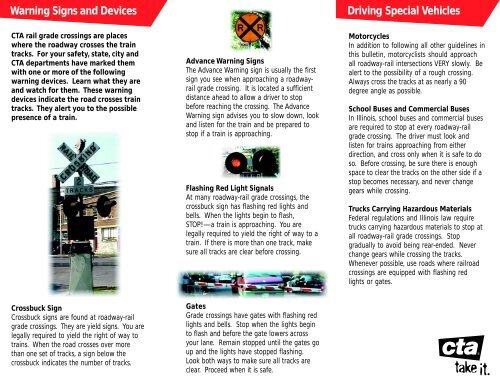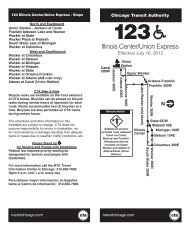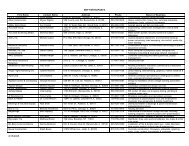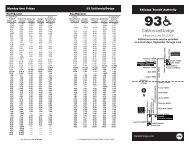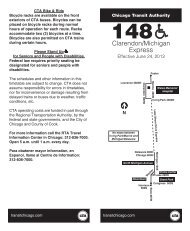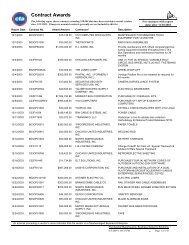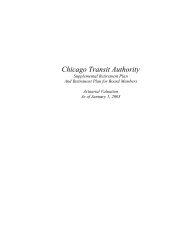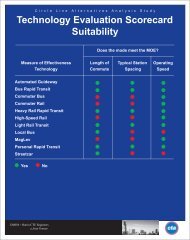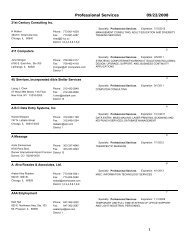Or driving Behind Trucks With Hazardous Materials Placards
Or driving Behind Trucks With Hazardous Materials Placards
Or driving Behind Trucks With Hazardous Materials Placards
Create successful ePaper yourself
Turn your PDF publications into a flip-book with our unique Google optimized e-Paper software.
Warning Signs and Devices<br />
Driving Special Vehicles<br />
CTA rail grade crossings are places<br />
where the roadway crosses the train<br />
tracks. For your safety, state, city and<br />
CTA departments have marked them<br />
with one or more of the following<br />
warning devices. Learn what they are<br />
and watch for them. These warning<br />
devices indicate the road crosses train<br />
tracks. They alert you to the possible<br />
presence of a train.<br />
Advance Warning Signs<br />
The Advance Warning sign is usually the first<br />
sign you see when approaching a roadwayrail<br />
grade crossing. It is located a sufficient<br />
distance ahead to allow a driver to stop<br />
before reaching the crossing. The Advance<br />
Warning sign advises you to slow down, look<br />
and listen for the train and be prepared to<br />
stop if a train is approaching.<br />
Flashing Red Light Signals<br />
At many roadway-rail grade crossings, the<br />
crossbuck sign has flashing red lights and<br />
bells. When the lights begin to flash,<br />
STOP!—a train is approaching. You are<br />
legally required to yield the right of way to a<br />
train. If there is more than one track, make<br />
sure all tracks are clear before crossing.<br />
Motorcycles<br />
In addition to following all other guidelines in<br />
this bulletin, motorcyclists should approach<br />
all roadway-rail intersections VERY slowly. Be<br />
alert to the possibility of a rough crossing.<br />
Always cross the tracks at as nearly a 90<br />
degree angle as possible.<br />
School Buses and Commercial Buses<br />
In Illinois, school buses and commercial buses<br />
are required to stop at every roadway-rail<br />
grade crossing. The driver must look and<br />
listen for trains approaching from either<br />
direction, and cross only when it is safe to do<br />
so. Before crossing, be sure there is enough<br />
space to clear the tracks on the other side if a<br />
stop becomes necessary, and never change<br />
gears while crossing.<br />
<strong>Trucks</strong> Carrying <strong>Hazardous</strong> <strong>Materials</strong><br />
Federal regulations and Illinois law require<br />
trucks carrying hazardous materials to stop at<br />
all roadway-rail grade crossings. Stop<br />
gradually to avoid being rear-ended. Never<br />
change gears while crossing the tracks.<br />
Whenever possible, use roads where railroad<br />
crossings are equipped with flashing red<br />
lights or gates.<br />
Crossbuck Sign<br />
Crossbuck signs are found at roadway-rail<br />
grade crossings. They are yield signs. You are<br />
legally required to yield the right of way to<br />
trains. When the road crosses over more<br />
than one set of tracks, a sign below the<br />
crossbuck indicates the number of tracks.<br />
Gates<br />
Grade crossings have gates with flashing red<br />
lights and bells. Stop when the lights begin<br />
to flash and before the gate lowers across<br />
your lane. Remain stopped until the gates go<br />
up and the lights have stopped flashing.<br />
Look both ways to make sure all tracks are<br />
clear. Proceed when it is safe.<br />
®


